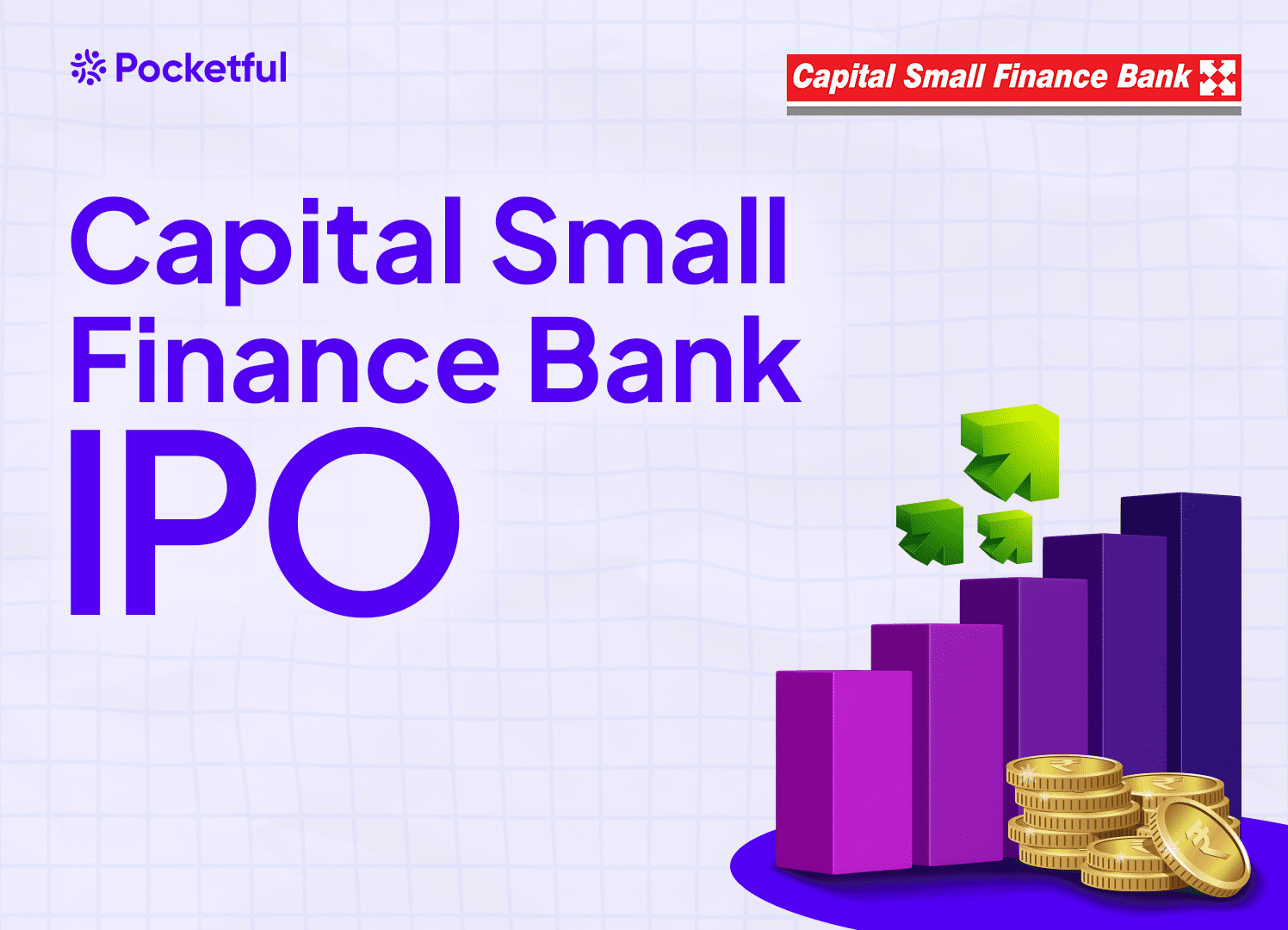| Type | Description | Contributor | Date |
|---|---|---|---|
| Post created | Pocketful Team | Feb-12-24 | |
| Update Formatting | Nisha | Feb-25-25 |

- Blog
- ipo alert capital small finance bank
IPO Alert – Capital Small Finance Bank

India’s investor community has come a long way from investing in bank fixed deposits to participating in initial public offerings (IPOs), a relatively riskier alternative. Initially, people hesitated to invest even in a renowned company, but nowadays, they are actively interested in initial public offerings (IPOs).
You would be surprised to hear that in 2022, the Indian stock market reported the third-highest number of initial public offerings (IPOs) globally. Additionally, India saw several fantastic initial public offerings (IPOs) in 2023, some of which allowed investors to earn over 90% in listing gains!
In today’s blog, we will explore another IPO, Capital Small Finance Bank.
If you haven’t read our blog on Jana Small Finance IPO, click here to check it out.
Overview of the company

Initially founded as Capital Local Area Bank(CLAB), Capital Small Finance Bank mostly operated in Punjab. With RBI’s approval on April 24, 2016, it became India’s first small finance.
In February 2017, it received the designation of a ‘scheduled bank’ (these banks get access to low-interest loans from RBI), which allowed it to increase its lending and borrowing capabilities.
Capital Small Finance Bank started its business operations with 39 branches but currently operate around 1000 branches in the country.
Promoters
The Samara Family is in charge of the Capital Small Finance Bank, and Mr Sarvjit Singh Samra serves as both the institution’s managing director and CEO. In the year 2000, he was instrumental in the founding of Capital Local Area Bank.
Dinesh Gupta, Amarjit Singh Samara, Navneet Kaur Samara, and Surinder Singh Samara are other family members who are regarded as promoters.
The promoters group holds approximately 24% of Capital Small Finance Bank Shares.
Details of the issue
Capital Small Finance Bank is proposing an IPO of Rs. 523.07 crore. The IPO consists of an offer for sale of 73.07 crore and a fresh issue of Rs. 450 crore.
The Capital Small Finance Bank IPO is open to the public from February 7 to February 9, 2024. The shares will be allotted in full on February 12th, 2024, with a listing date of February 14th on the NSE and BSE.
Timeline of the IPO
| IPO Open Date | 7th Feb 2024 |
| IPO Close Date | 9th Feb 2024 |
| Finalization of Allotment | 12th Feb 2024 |
| Initiation of Refund | 13th Feb 2024 |
| Credit of Shares into a Demat Account | 13th Feb 2024 |
| Listing Date on NSE & BSE | 14th Feb 2024 |
Details of the IPO
| Face Value of Share | Rs. 10 |
| Price Band | Rs. 445 – 468 per share |
| Market Lot | 32 Shares |
| Total Issue Size | Rs. 523.07 Crores |
| Total Number of Shares | 1,11,76,713 shares |
| Fresh Issue Size | Rs. 450 Crore |
| Offer for Sale | Rs. 73.07 Crore |
| Listing Exchange | NSE & BSE |
Objective of the Issue
The main objective of Capital Small Finance Bank is to use the funds from the offering to meet the bank’s projected future capital needs, and the issue costs may also be covered using the money that was raised.
IPO Allotment Size
The table below displays the minimum and maximum number of shares that an investor is eligible to apply for.
| Applicant | Market Lot | Share | Amount |
|---|---|---|---|
| Retailer (Min) | 1 | 32 | 14,976 |
| Retailer (Max) | 13 | 416 | 1,94,668 |
| Small High Net Worth Individual (Min) | 14 | 448 | 209,664 |
| Small High Net Worth Individual (Max) | 66 | 2,112 | 9,88,416 |
| Ultra High Net Worth Individual (Min) | 67 | 2,144 | 10,03,392 |
The aforementioned figures showcase that a retail investor can invest a minimum of INR 14,976 rupees and a maximum of INR 1,94,668.
Lead Managers
Equirus Capital Private Limited, DAM Capital Advisors Limited, and Navuma Wealth Management Limited are the firms in charge of managing the Capital Small Finance Bank IPO procedure.
Read Also: IPO Alert: Jana Small Finance Bank
Financial Highlights of Capital Small Finance Bank (In crores, unless stated otherwise)

| Particulars | 31 Mar 2023 | 31 Mar 2022 | 31 Mar 2021 |
|---|---|---|---|
| Assets | 7,990.77 | 7,153.92 | 6,371.24 |
| Revenue | 725.48 | 632.40 | 557.27 |
| Profit After Tax | 93.60 | 62.57 | 40.78 |
| Reserve & Surplus | 576.36 | 481.74 | 416.88 |
| Total Borrowings | 721.38 | 498.43 | 616.72 |
| Capital Adequacy Ratio – Total Capital (CRAR) (%) | 18.87% | 18.63% | 19.8% |
| Net NPA (NNPA) (%) | 1.36% | 1.36& | 1.13% |
| Net Interest Margin (NIM) (%) | 4.19% | 3.74% | 3.36% |
| CASA Ratio (%) | 41.88% | 42.16% | 40.08% |
Both the revenue and the assets have significantly improved which suggests that the bank is operating profitably. Additionally, not only did the bank’s clients increase, but the profit after tax also rose by almost 50% y-o-y in FY23.
The CASA ratio indicates that the bank has access to a stable and consistent source of cheap money as interest rates on Savings and Current account holdings are much lower than traditional borrowings.
The Net NPA ratio showcases the bank’s efficiency in providing loans only to credit-worthy individuals and institutions. A consistent rate of 1.3% is much lower than the industry average of 3-4%.
A healthy NIM of around 4% indicates stability even in an environment where all major banks saw a decrease in NIM.
Additional Key Performance Indicators (KPIs)
ROE – Capital Small Finance Bank’s return on equity ratio rose to 16.62% in FY23 from 12.95% in FY22.
RoE is the ratio of profit after tax to average net worth.
EPS – Capital Small Finance Bank’s earnings per share rose to 27.35 in FY23 and 18.41 in FY22.
This crucial financial ratio establishes the company’s profitability. It is computed by dividing net income by the total number of outstanding shares of the corporation.
P/E Ratio – Currently, the price-to-earnings ratio stands in the range of 16.27 to 17.11, based on the lower and upper end of the price band.
The amount an investor is willing to pay for a single share of a company for one rupee of its earnings is referred to as the PE ratio.
Risks
- Competition – The small finance banking industry is extremely competitive, with many players entering the market and even getting into the public domain via launching IPOs. This may cause some serious issues as fierce competition leads to decreased margins and market share.
- Negative Cash Flow – The bank has a history of having negative cash flow from operating activities. In FY23, CFO stood at -107.44 Crores, and in FY22, CFO was -210.74 Crores. The bank’s inability to generate positive cash flow from a money-making business like banking could be indicative of deeper inefficiencies that are more qualitative than quantitative.
- High attrition rate – In FY23, the bank faced an attrition rate of 19.82%. This is extremely high and showcases the dissatisfaction among the workforce. This could translate into decreased margins in the coming years.
- RBI Crackdown impending – As of now, the small finance banking industry has been allowed many relaxed requirements that other banks have to face. If RBI decides to take some of those relaxations away, then it could dramatically affect the margins of these banks.
- Geographical concentration – As of FY23, 87% of the branches were in Punjab and 96.44% of deposits came from the region. This could be indicative of the bank’s unwillingness to expand beyond Punjab, to other regions of the country.
Read Also: Small Finance Bank Share List in India 2025
Conclusion
Investors have a fantastic opportunity to access a bank with a strong and profitable track record in the market through the initial public offering (IPO). Currently, the bank offers a varied loan portfolio with robust growth in both revenue and margin over the years.
Investing in initial public offerings (IPOs) involves conducting extensive research on the regularities that the companies must meet.
The suitability of investment in an IPO depends on an individual’s risk horizon and financial objective. So, you must do your research before investing!
Frequently Asked Questions (FAQs)
How can I participate in the Capital Small Finance Bank IPO?
You can participate in Capital Small Finance Bank IPO through your demat account via ASBA (Application Supported by Blocked Amount) or UPI (through the broker).
What will happen after I subscribe for the IPO?
Shares are listed on the exchange after you subscribe for the initial public offering (IPO), at which point you can purchase and/or sell shares.
Does the bank have enough capital to support its deposits/liabilities in case of emergency?
The Capital Adequacy ratio, as prescribed by RBI, has to be above 15% for Small finance banks, and the Capital Small finance bank has consistently beaten this requirement by at least 3%.
What is the issue price of the Capital Small Finance Bank IPO?
The price band of Capital Small Finance Bank IPO is 445 to 468 INR.
Why is Capital Small Finance Bank going public?
Capital Small Finance is going public to meet capital requirements.
Disclaimer
The securities, funds, and strategies discussed in this blog are provided for informational purposes only. They do not represent endorsements or recommendations. Investors should conduct their own research and seek professional advice before making any investment decisions.